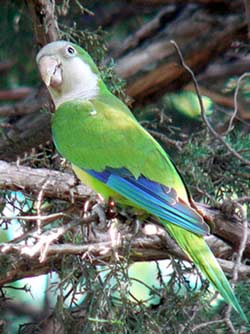Parrots are able to use tongues to speak
Previously, it was not clear what made parrots capable of 'mimicking' very well the human voice? It turned out that these feathered, artistic imitators also used tongues to create sounds similar to vowels, just like we usually do.

"Monk parrot" - Myiopsitta Monachus
( Photo: backyardbirdcam)
When the speaker speaks, the sound is produced in the larynx and can then be altered by the movement of the tongue in the oral cavity so that we can create complex vowels and consonants.
In the past, many researchers thought that birds created and transformed sounds by means of an esophagus - a larynx-like organ. Tongue plays no role in this process.
It is known that parrots also push their tongues when 'speaking', so Gabriel Beckers from Leiden University - Netherlands - and colleagues decided to study how much these movements contribute to the ability. their 'parody' ability . Their results are published in Current Biology.
The research team conducted on 5 wild monks' parrots (Myiopsitta monachus). They were arrested and killed as part of the government pest management program in Florida. In each experiment, they replaced their control with a tiny radio and then used a hook to move their tongue while the amplifier played a negative source. The research team saw, with movement The tongue is less than a millimeter, making a big difference in the sound quality, called a formant. Beckers said 'it's bigger than the difference between' a 'and' o 'in humans'. He thought that they were able to use the tongue skillfully to accurately describe the sounds, as a basis for their pre-capture ability.
Irene Pepperberg, Massachusetts Institute of Technology, who specializes in bird speech, said: 'In nature, parrots seem to use these sounds to communicate. Small differences in sound are very important to these birds. ' She took the example between sparrow and parrot to demonstrate: In sparrows, males sing only in certain seasons of the year - attracting females. In contrast, parrots sing all year round. They certainly used formants and other sounds to convey complex information such as identification of the same type, warning of dangers.
Berkers said: 'This finding shows that the communication of parrots may be more complicated than we think'.
Pepperberg has direct data in this area. Her team studied the laboratory African gray parrot called Alex over 27 years. Alex can accurately describe sounds for objects, shapes, colors and materials, distinguish concepts that are similar and different and demand laboratory workers to change its environment.
Pepperberg said that this ability of parrots is harmless, it contributes to their language wealth.
Recent studies suggest that at least two species have the ability to produce human and parrot formants. The activity of the tongue creates a complex tone, a phenomenon proved to be beneficial for both species.

"Monk parrot" - Myiopsitta Monachus (Photo: pelicanman)
- Parrots speak 2 languages
- Decipher the secret that makes parrots talk
- Parrots help people paralyze back
- The story of the animals
- Some animals are famous for their human speaking
- Surprised by the ability of the parrot to make food
- Smart parrots like people
- Discover new parrot species in Mexico, green head 'crown'
- Shocking news: Brazil's
- Parrots know the benefits of sharing?
- Parrots are extremely intelligent species but why are they capable of that?
- Parrots teach children to practice speaking
 Animal 'suffering' after hibernation
Animal 'suffering' after hibernation Why do goats climb well?
Why do goats climb well? Scientists were surprised to see chimpanzees eating turtles
Scientists were surprised to see chimpanzees eating turtles Giant catfish died deadly due to drought in Thailand
Giant catfish died deadly due to drought in Thailand